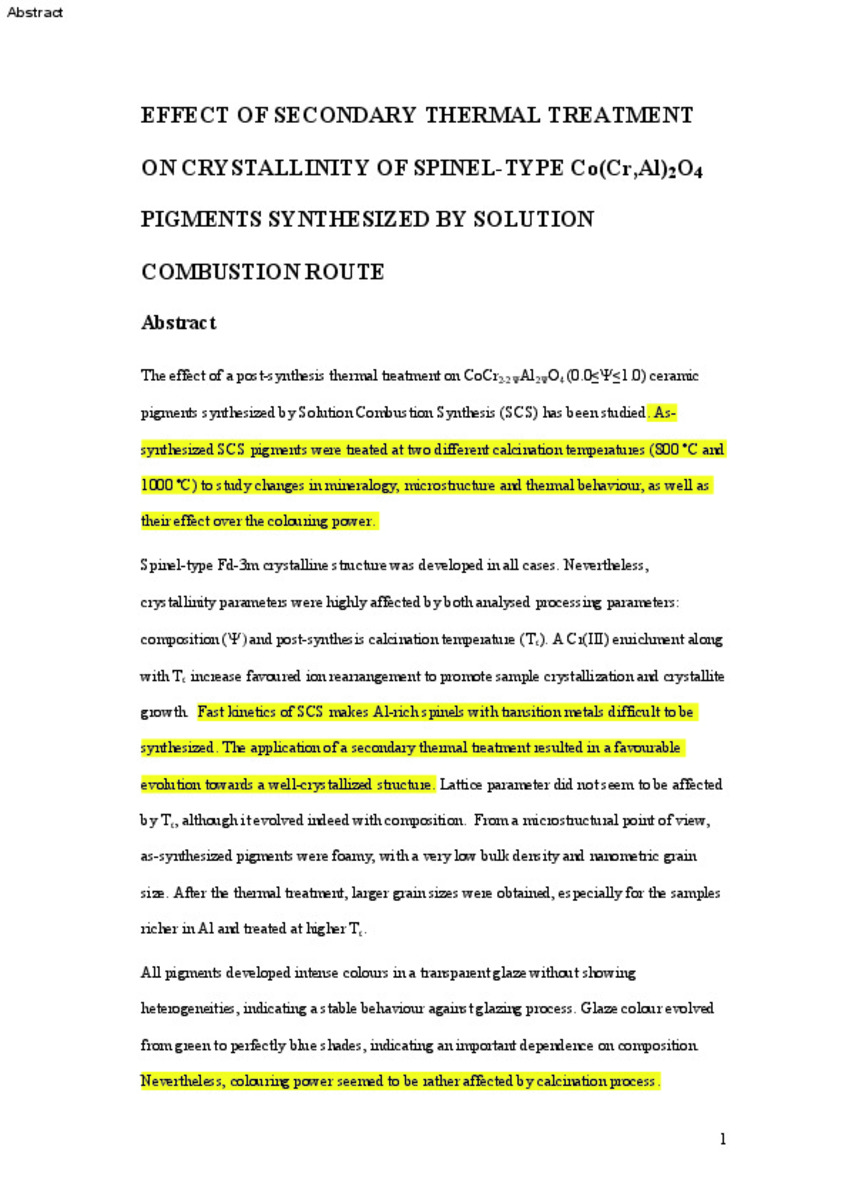Mostrar el registro sencillo del ítem
Effect of secondary thermal treatment on crystallinity of spinel-type Co(Cr, Al)2O4 pigments synthesized by solution combustion route
| dc.contributor.author | Gilabert, Jessica | |
| dc.contributor.author | Gómez-Tena, Maria Pilar | |
| dc.contributor.author | Sanz-Solana, Vicente | |
| dc.contributor.author | Mestre Beltrán, Sergio | |
| dc.date.accessioned | 2018-12-20T12:22:29Z | |
| dc.date.available | 2018-12-20T12:22:29Z | |
| dc.date.issued | 2018-03 | |
| dc.identifier.citation | GILABERT, J., et al. Effect of secondary thermal treatment on crystallinity of spinel-type Co (Cr, Al) 2O4 pigments synthesized by solution combustion route. Journal of Non-Crystalline Solids, 2018, Volume 501, pp: 62-70 | ca_CA |
| dc.identifier.uri | http://hdl.handle.net/10234/178318 | |
| dc.description.abstract | The effect of a post-synthesis thermal treatment on CoCr2−2ΨAl2ΨO4 (0.0 ≤ Ψ ≤ 1.0) ceramic pigments synthesized by Solution Combustion Synthesis (SCS) has been studied. As-synthesized SCS pigments were treated at two different calcination temperatures (800 °C and 1000 °C) to study changes in mineralogy, microstructure and thermal behaviour, as well as their effect over the colouring power. Spinel-type Fd-3m crystalline structure was developed in all cases. Nevertheless, crystallinity parameters were highly affected by both analysed processing parameters: composition (Ψ) and post-synthesis calcination temperature (Tc). A Cr(III) enrichment along with Tc increase favoured ion rearrangement to promote sample crystallization and crystallite growth. Fast kinetics of SCS makes Al-rich spinels with transition metals difficult to be synthesized. The application of a secondary thermal treatment resulted in a favourable evolution towards a well-crystallized structure. Lattice parameter did not seem to be affected by Tc, although it evolved indeed with composition. From a microstructural point of view, as-synthesized pigments were foamy, with a very low bulk density and nanometric grain size. After the thermal treatment, larger grain sizes were obtained, especially for the samples richer in Al and treated at higher Tc. All pigments developed intense colours in a transparent glaze without showing heterogeneities, indicating a stable behaviour against glazing process. Glaze colour evolved from green to perfectly blue shades, indicating an important dependence on composition. Nevertheless, colouring power seemed to be rather affected by calcination process. | ca_CA |
| dc.format.extent | 8 p. | ca_CA |
| dc.format.mimetype | application/pdf | ca_CA |
| dc.language.iso | eng | ca_CA |
| dc.publisher | Elsevier | ca_CA |
| dc.rights | © 2018 Elsevier B.V. All rights reserved. | ca_CA |
| dc.rights.uri | http://rightsstatements.org/vocab/InC/1.0/ | * |
| dc.subject | combustion synthesis | ca_CA |
| dc.subject | pigment | ca_CA |
| dc.subject | spinels | ca_CA |
| dc.subject | crystallinity | ca_CA |
| dc.subject | microstructure | ca_CA |
| dc.title | Effect of secondary thermal treatment on crystallinity of spinel-type Co(Cr, Al)2O4 pigments synthesized by solution combustion route | ca_CA |
| dc.type | info:eu-repo/semantics/article | ca_CA |
| dc.identifier.doi | https://doi.org/10.1016/j.jnoncrysol.2018.02.026 | |
| dc.relation.projectID | Universitat Jaume I (Project Nr. P11B2015-04). | ca_CA |
| dc.rights.accessRights | info:eu-repo/semantics/openAccess | ca_CA |
| dc.relation.publisherVersion | https://www.sciencedirect.com/science/article/pii/S0022309318300930 | ca_CA |
| dc.type.version | info:eu-repo/semantics/submittedVersion | ca_CA |
Ficheros en el ítem
Este ítem aparece en la(s) siguiente(s) colección(ones)
-
QUI_Articles [296]
-
ITC_Articles [75]







